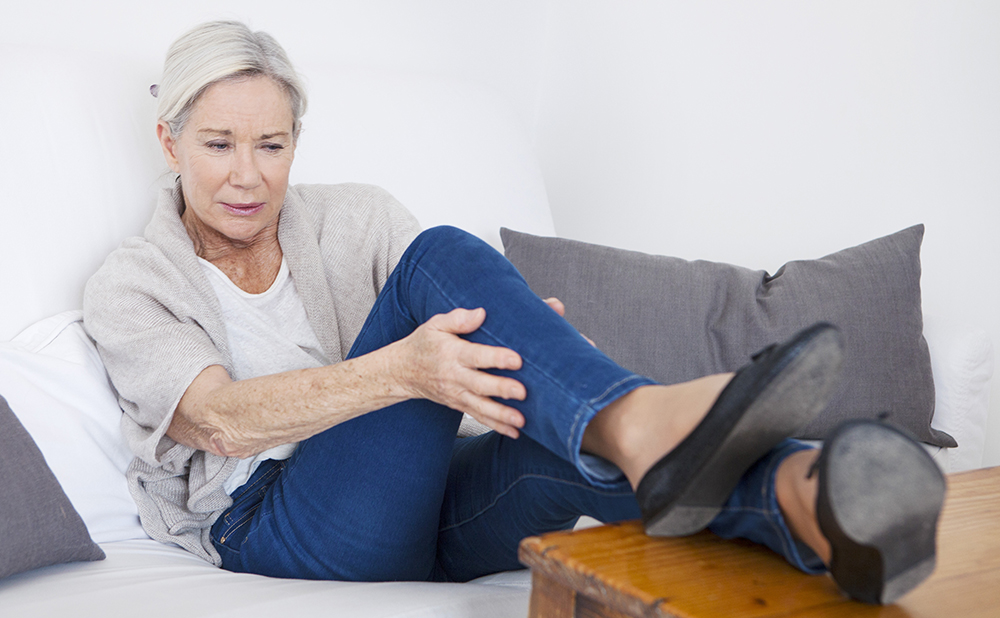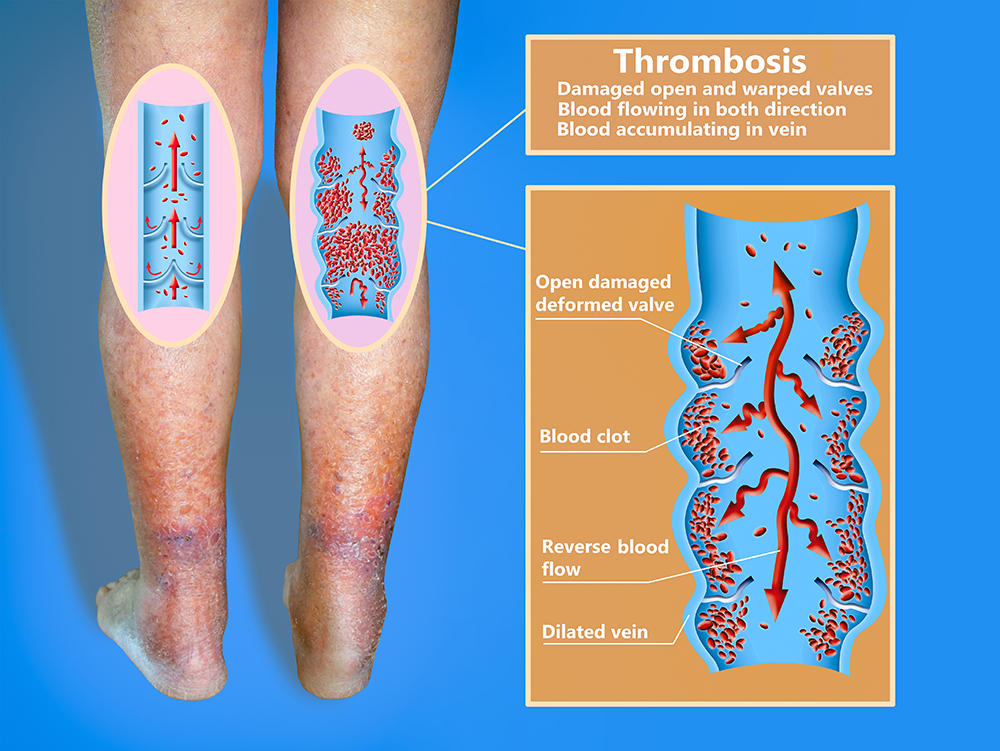Leg pain is a common occurrence, and the most likely culprit to calf pain is cramps, muscle strain, or tired muscles. This article aims to demystify a large portion of the possible reasons for calf pain to make you more informed. Calf pain can be caused by a multitude of different things from simply tired muscles all the way to thrombosis.
If you are concerned about your calf pain you should consult a doctor to rule out any potentially serious conditions, but this article should help give you a good starting point to figure out what’s going on.
#1: Muscle Strain
Muscle strains are amongst the most common reasons an individual can experience calf pain. A muscle strain is essentially a tearing of the muscle that can result in pain, tightness, and inflammation. A muscle strain in the calf will feel like the muscle is tight and can be painful depending on the severity. It may be difficult to point your toes and your muscles may become swollen. A muscle strain is typically an acute development of pain that follows some form of wrong movement or strenuous activity.
To treat a muscle strain you should follow the PRICE protocol, which is an acronym that stands for:
- Protect
- Rest
- Ice
- Compression
- Elevation
In addition to the PRICE protocol, the utilization of topical muscle pain relief creams can be effective in reducing calf pain from a strain. The Hempvana Pain Relief Cream lineup is the gold standard for what a topical analgesic should be. With three different creams available, Hempvana has you covered with soothing ingredients for fast relief, that also work to nourish your skin, too.

#2: Tired Muscles
Muscles are non-stop machines that work tirelessly to allow you to live your daily life. Just like any machine, muscles can get overworked and can become sore and tired from constantly contracting and relaxing.
The easiest way to determine if calf pain is a result of having tired muscles is to determine if you have performed a strenuous or long activity recently. Standing on your feet for hours on end, walking long distances, going up a lot of stairs, walking uphill, and other activities where you utilize your calf muscles can lead to tired and sore muscles without you even noticing during the actual activity.
To treat calf pain as a result of overworked and tired muscles there are limited actions you can take. You can apply Hempvana Cold as Ice to relieve some of the discomfort but the main treatment for sore muscles is to give them time to rest and recover.
#3: Peripheral Artery Disease
A less common cause of calf pain can be Peripheral Artery Disease (PAD). PAD is characterized by the narrowing of the blood vessels in the peripheral circulatory system. The peripheral circulation includes the circulation that serves the legs, feet, arm, and hands.
PAD calf pain would be only present during any movement and would subside during inactivity. This pain is caused due to insufficient oxygen being supplied to the muscles of the peripheral circulation. When muscles do not have adequate oxygenation, muscles produce what is known as lactic acid. Lactic acid is a chemical that causes soreness after a workout.
Potential solutions to PAD calf pain involves healthy lifestyle changes. The gradual blockage of arteries in the peripheral system is more often than not caused by a less than ideal diet and a sedentary lifestyle. One possible solution to PAD is to walk more often. This may seem counterintuitive as walking causes the pain, but walking more will help improve circulation to the area and therefore alleviate symptoms over time.

#4: Thrombosis
Another unlikely but problematic reason a calf may hurt while walking is thrombosis. A thrombosis is a blood clot within the circulatory system. These can be caused by many different variables but one risk factor that is well-known is being sedentary for long durations.
Thrombosis in the calf can potentially be life-threatening if it is a deep vein thrombosis. A deep vein thrombosis in the leg is dangerous because the veins lead back into the lungs. With small capillaries lining the lungs, a blood clot can get stuck in the lungs and result in cutting off blood supply to a portion of the lungs leading to tissue death. This is known as a pulmonary embolism and can be life-threatening.
A thrombosis needs to be treated by a licensed physician and if thrombosis is suspected it is imperative to seek medical attention as soon as possible.
#5: Bone Fracture
While a complete bone break would be an obvious sign of concern, some bone fractures are only a small crack or chip in the bone. These less obvious bone fractures can result in radiating pain that can worsen when walking. The most telling sign of whether to be concerned about a bone fracture is to determine if you have experienced any trauma to the area in the recent past.
If a bone fracture is suspected it is important to seek medical attention to rule out a fracture or ensure the bone fracture is adequately immobilized to prevent further damage to the bone.
Depending on the type of leg fracture there are a wide variety of possible solutions. For full breaks a leg may be immobilized through the use of surgical hardware installed within the body or a cast may be worn to immobilize the bone till it has healed.
#6: Laceration
A laceration, more commonly known as a cut or break in the skin, can also cause calf pain when walking. If there’s a wound that is still healing on the calf or perhaps has stitches, it is normal to feel discomfort when walking as the skin is stretched and pulled. The laceration could also rub against clothing and result in pain while walking. If the laceration is infected it is advised to seek medical assistance to treat the infection.
One of the best ways to treat calf pain while walking that is caused by a laceration is to follow proper wound care to promote healing. This includes keeping the wound moist, protecting the wound with bandages, and keeping it clean. Having the wound bound in a bandage will reduce the chances it will snag on clothing and will provide some relief.
#7: Contusion
A contusion is an internal wound typically caused by blunt force trauma. This is more commonly known as a bruise and can lead to pain and tenderness. A bruised calf can definitely cause pain to the area when walking.
One of the best ways to determine if the pain is from a bruise is to decide if the area encountered some kind of blunt force. If it did and the skin changes pigmentation it can be a sign of a contusion. The presence of a bruise can be indicative of other conditions like a bone break and as such, it is important to ensure you seek medical advice if there are significant pain and discoloration.
#8: Cramps
Cramps are a muscle spasm that can occur in almost every muscle of your body. A cramp typically is an acute sharp pain that is alongside a sensation of muscle tension. There are many factors that contribute to the formation of a cramp which include dehydration, electrolyte deficiency, overexertion, and more.
The best way to treat a cramp immediately is to stretch and massage out the tightness in the muscle and follow this up with drinking an electrolyte-rich drink to ensure your electrolyte levels are restored. Some cramps may be painful and as such, could benefit from the topical soothing properties of Hempvana Gold Pain Relief Cream with Turmeric & Aloe.
#9: Diabetic Neuropathy
Another unusual possible cause of calf pain is diabetic neuropathy. Diabetic neuropathy is a condition that affects those with diabetes mellitus (type 2 diabetes). Sustained high blood sugar levels can lead to nerve damage and as such can result in those with diabetes experiencing a loss of sensation in the lower extremities as well as shooting neuropathy-associated pain.
There is no real solution to nerve damage associated with diabetes. The most an individual can do is alter their lifestyle to limit any further nerve damage. If you believe you are experiencing calf pain as a result of diabetes seek medical help to reduce the chances of further nerve damage.
Conclusion
In conclusion, calf pain is a frequent occurrence and is typically nothing that needs to be worried about. The list above is just a list of many possible causes and possible solutions to calf pain. Seeking out medical expertise is the only sure way to determine the causation of your calf pain and the appropriate treatment, but in the meantime, you can get some relief from Hempvana’s Pain Relief line!
